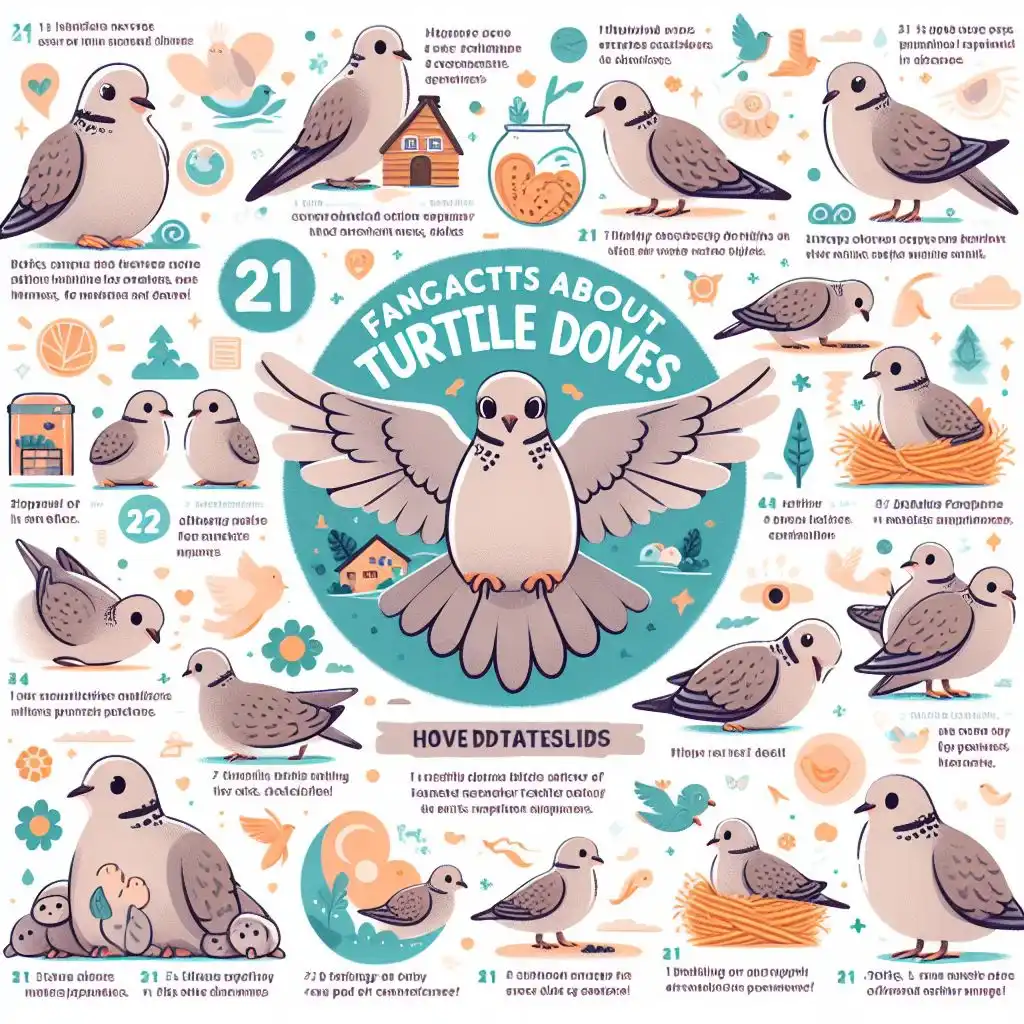
The European turtle dove is scientifically known as Streptopelia turtur. It is a bird species facing significant population decline, classified as "vulnerable" to extinction globally. Here are 21 facts about turtle doves:
| Key Point | key facts about the European turtle doves |
|---|---|
| Appearance | Small dove with mottled brown and black wings, black tail, pale breast, and black-and-white-striped neck patch |
| Migration | Undertakes long migrations between Europe and Africa, covering up to 6,800 miles, with individuals flying up to 37 mph |
| Behavior | Monogamous, forming lifelong pair bonds, with both parents participating in nest-building and incubating eggs |
| Population Decline | There has been a dramatic decline of up to 98% in the UK since 1970, primarily due to habitat loss, agricultural changes, and illegal hunting |
| Conservation Status | Listed as "Vulnerable" globally by IUCN and on the Red List of conservation concern in the UK |
| Cultural Significance | Symbolizes devoted love in various cultures, often referenced in literature and folklore, with a distinctive 'turr turr' call |
| Habitat | Prefers deciduous woodlands and hedgerows in southern and eastern England, arriving in late April/May and departing in July/September |
List of 21 facts about turtle doves
Here summarizing 21 key facts about the European turtle dove:
Why is it called a turtle dove?

Its unusual cry is why the European turtle dove is called a "turtle dove," with no link to turtles or tortoises. A mixture of Old English turtla, from Latin turtur "turtledove," turtledove resembles the bird's call. Dove is a derivation of the word dive and stems from Old English dufe, dūfe. Other Germanic languages have analogous forms. English originally used turtledove in the fourteenth century.
Where are turtle doves found?
The habitat of the European turtle dove includes a wide range of environments. It has such types as steppe, semi-desert, and various forest types. In the UK, turtle doves typically nest in tall trees. It has nest-wide mature scrub or hedgerows, especially those containing standard trees, thorny shrubs, and climbers.
What do Turtle Doves look like?

The European turtle dove is smaller and slighter than many other doves. It measures 26–28 cm in length, 47–53 cm in wingspan, and weighs 100–156 g. It features a browner coloration and a black-and-white-striped neck patch. It has a distinctive wedge-shaped tail with dark and white markings.
The mature European turtle dove boasts a distinctive appearance. It features a blue-grey head, neck, flanks, and rump, complemented. It has cinnamon wings mottled with black, a vinaceous breast, and a white abdomen.
what is the scientific name of turtle doves?
The scientific name of the European turtle dove is Streptopelia turtur.
What do turtle doves symbolize?
Genesis 15:9 tells us that the Lord God gave Abraham orders to give a pigeon and a turtle dove as part of a sacrifice. Leviticus states that two turtle doves were used for the trespass sacrifice (Lev. 5:7). a turtle dove was used in the burnt offering (Lev. 1:14).
A phrase of fondness for one cherished is given to the turtle dove in Psalm 74:19. The turtle's voice is reported as being heard throughout the nation in Song of Solomon 2:12. After Jesus' birth,. Mary brought a pair of turtledoves (Luke 2:24) as a sacrifice for those who could not afford a lamb or bullock.
Turtle doves are monogamous, forming lifelong pairs. Turtle doves are famous for their smooth purring sound, "tuurrr tuurrrr tuurrrr." It is a characteristic aspect of their courting and communication activities.
What is the diet of turtledoves?
They rely on arable farmland for feeding and prefer to nest in mature hedgerows, scrub, and open woodland. It is mainly found in the southern and eastern regions. The diet of turtle doves primarily consists of seeds. It has a preference for the seeds of cereals and weeds like chickweed and fumitory. They are ground feeders and will also consume spill grain and the seeds of oilseed rape.
what is the behavior of turtle doves during migration?
During migration, European turtle doves exhibit largely nocturnal movements. The majority of location fixes were recorded at night. They spend about two-thirds of the year away from their breeding grounds.
It engages in active migration and wintering in sub-Saharan Africa. Turtle doves show weak migratory connectivity. some individuals carrying out loop migration and utilizing less strictly defined migration flyways. Their migration patterns are influenced by environmental factors.
How fast do mourning doves mate for life?

Mourning doves are known to be monogamous for an entire breeding season. There is some evidence that they may re-pair in succeeding breeding seasons. About two weeks later, the eggs hatch and both parents care for the young until they leave the nest when they are eleven or fifteen days old. One summer, a couple may raise two families. Mourning doves couple for life, or seven to ten years. They will find a new partner, however, if one is slain.
How long does a turtle dove live?

The average lifespan of a European turtle dove is not definitively known, but some estimates suggest that the lifespan is 6 years and 3 months for a bird ringed in the UK. According to a Spanish investigation, the annual survival rates for adults were 0.597, and for adolescents were 0.311. It is generally known that turtle doves create lasting pair ties. Certain connections it has might survive several breeding seasons.
How Fast Do Mourning Doves Fly?
The quickest a mourning dove can fly is 88 km/h (55 mph). Their exceptional flying skills are well known; on one occasion, a flight speed of 30 to 35 miles per hour was measured. Furthermore, mourning doves are reported to fly rapidly and straight as bullets.
Where do mourning doves sleep?
Mourning doves typically sleep in trees or shrubs, perching on branches or in dense foliage to rest during the night. They prefer roosting in elevated locations that provide safety from ground predators.
Why are turtle doves special?
Turtle doves are remarkable in their own right and have tremendous ecological importance. Out of all the columbiform birds, they are the only ones traveling large distances. Its migration routes between Europe and sub-Saharan Africa are as follows:. The dramatic reduction in the population of Europe underscores the necessity of conservation programs. Within ecosystems, turtle doves are crucial.
What is the myth of the turtle dove?
Fides, the goddess of good faith (as in the Latin term bona fide), was frequently portrayed cradling a turtle dove. Greek tradition claims that the birds pulled the love goddess Aphrodite's chariot. Chaucer writes of "the married turtledove with her heart true" in his Parlement of Foules.
What’s the difference between a dove and a turtle dove?
Smaller and darker than the collared dove, the Turtle Dove is larger than a blackbird. Its black tail has a white border, and its upper regions are brilliantly mottled with chestnut and black. Migratory, turtle doves spend the winter in Africa.
What is the conservation status of turtle doves?
The conservation status of turtle doves is classified as "vulnerable" globally by the IUCN Red List of Threatened Species. Of the dove and pigeon family of birds, the Columbidae, the European turtle dove is an endangered or vulnerable member. While it winters in northern sub-Saharan Africa, it breeds in a broad range of the southwestern Palearctic, including North Africa.

